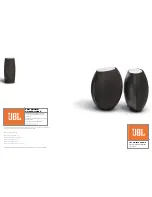
page 2 of 2
Rev. A
For 5-1/4", 6-1/2" & 8" Round In-Ceiling
For 5-1/4", 6-1/2" & 8" Round In-Ceiling
and sufficient length at the other end to reach the electronics.
Having to add extra cable later can be tedious and time
consuming.
Avoid bundling speaker cables parallel to electrical cables
for extended lengths. Though the impedance is low and the
likelihood of interference low, this may help reduce
hum and RF interference. When securing the
cable, use care not to staple or nail the electrical
conductors. Doing so could result in a short that
might damage the electronics.
More than two pair of these speakers can be
connected to one amplifier. However, we suggest that
you consult a professional if you are installing more than two
pair.
When connecting your speakers, make sure proper polarity
(phasing) is maintained. Simply put, this means being sure
the same wire which is hooked to the positive terminal of the
amplifier has its other end hooked to the positive terminal of
the speaker. It is important to check this on all speakers. If the
connections on one of the speakers are reversed, (out of phase)
the quality of your bass will be seriously impaired.
INSTALLATION
If the speaker locations have not yet been established then
do so now. Assess the ceiling area for possible concealed
obstructions such as wiring, plumbing, heating ducts, etc. This
is best done through an attic crawl space if available. Absence
of a crawl space will require greater study of observable
clues and may possibly require the use of inspection holes
and inspection tools (camera, mirror, flashlight, etc.). Use a
“stud finder” to locate the positions of the joists or rafters. We
recommend that the edge of the holes be at least ¾" (19mm)
away from joists or rafters whenever possible.
Once the speaker locations are established use the paper
template (the outside of the outer cardboard disc) or the plastic
protractor provided with your speaker to mark the speaker
cut-out. The hole diameters for the various
speakers are marked on the protractor.
Using the proper tool, cut the appropriate
sized hole in the wall. On drywall, clean
cuts can be made with a drywall saw.
If the cable has not yet been run, do so now
that you have access to the ceiling’s interior. Once the speaker
cable has been run, pull the end of the cable out of the ceiling,
strip back a section of the jacket as needed, and then expose ½"
(13mm) of each conductor.
To aid in speaker performance, a fibrous material, such as
fiberglass or polyester fiber, may be placed behind the speaker.
This may also help to reduce unwanted sound from being
transmitted into adjoining rooms. If the ceiling space has blown
or loose insulation, it is important to prevent the insulation from
entering the back of the speaker. This can be accomplished
by placing a batt of fiberglass insulation, fabric barrier, or bag
over the back of the speaker. Alternatively you may use an
Insu-Flate ISF-147,
which is an acoustically transparent fabric
cover specifically designed for this application. Placing a rigid
enclosure over the speakers can be done but the enclosure
should be large enough not to degrade the performance of the
speaker. Rigid enclosures of less than 0.75 cuft (21
liters) should be stuffed with acoustic insulation
such as fiberglass.
Remove the grilles from the speakers using the
supplied tool by hooking the grille near its edge.
As the drawing below shows, the speakers utilize
Toggle Clamps which, after tightening, hold the
speakers in place. Ensure that the toggle clamps are rotated
into their “home” position. This way, they will clear the edge of
the cut-out.
Verify that the speaker fits properly into the cut-out. If the hole
should have been cut a little too large the flange on the frame
should cover this. Remove the speaker from the hole.
Connect the wire conductors to the terminals on the back of the
speaker by depressing each spring terminal, inserting the wire
into the hole, and releasing the terminal. Use care to observe
the proper polarity (+ & -). Speakers wired out of phase will
exhibit an apparent loss of bass response.
Note:
Single-Point speakers
have both the left and right
channel connections on the same speaker. Ensure that
both channels are connected and in phase. An out of phase
connection to a single-point speaker will be immediately
obvious when signal is applied since there will be little if any
bass output. If disconnecting one of the inputs increases the
bass output then the inputs are out of phase.
Insert the speaker into the hole and tighten the installation
screws. As you start to turn each screw the toggle clamps will
rotate outward to engage the ceiling
material as shown. CAUTION: DO NOT
OVER-TIGHTEN THE CLAMPS. Too much
torque may damage the toggle, causing
the speaker not to seat securely. A snug
fit is all that is necessary to assure proper
performance.
If the speaker frames are to be painted,
either before or after installation, use the
paint-mask (the inner cardboard disc)
to cover the speaker driver(s) to prevent
damage. DO NOT PAINT THE GRILLE AND FRAME ASSEMBLY
TOGETHER. The grille should be painted separately. Use thin
coats and thin the paint as necessary to avoid clogging the
perforations with excessive paint.
If your speaker includes a pivoting tweeter aiming it toward the
listening area will raise the amplitude of the highest frequencies
(>12kHz), adding brilliance. USE CARE TO AVOID DAMAGING THE
DOME OF THE TWEETER WHEN AIMING!
RO
TA
TE
ISF-147




















